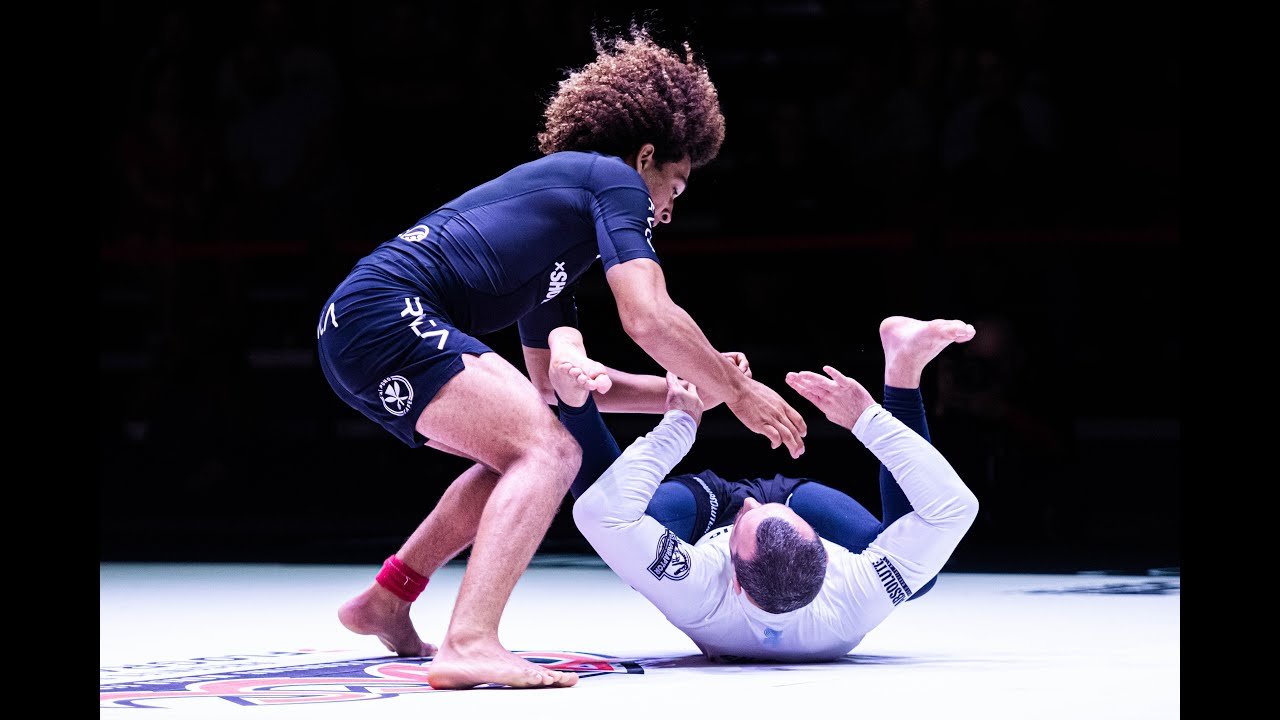
Pass Guards Like The Ruotolo Brothers | Lachlan Giles Breakdown
In this video breakdown titled “Pass Guards Like The Ruotolo Brothers,” Lachlan Giles discusses the strategies and techniques used by Cade Rotolo in his guard passing game. Giles focuses on three major areas of passing: the leg pin system, the north-south position, and dealing with leg entanglements. He highlights the effectiveness of Cade’s approach, particularly in the north-south position, where Cade displays a loose and unattached style of passing, surprising given the expectation of constant pressure. By forcing opponents into a gongoa roll to recover, Cade creates opportunities to get under the legs and execute successful passes. This breakdown offers valuable insights into Cade’s innovative approach and provides jiu jitsu enthusiasts with new techniques to consider when facing opponents who employ similar passing techniques.

Pass Guards Like The Ruotolo Brothers
Introduction to the Ruotolo Brothers
The Ruotolo Brothers, specifically Cade Ruotolo, have gained recognition in the jiu-jitsu community for their impressive guard passing skills. As a competitor in the same division as Cade, Lachlan Giles has taken the time to study their techniques and approaches to passing the guard. In this article, we will explore the different methods employed by the Ruotolo Brothers and discuss the ways in which their strategies differ from conventional guard passing techniques.
Different Approaches to Guard Passing
Before diving into the specific techniques used by the Ruotolo Brothers, it is important to understand the different approaches to guard passing. Guard passing involves overcoming an opponent’s defensive position, known as the guard, in order to establish a dominant position. There are various methods and systems that practitioners utilize to achieve this goal. The Ruotolo Brothers employ three major areas in their guard passing: the leg pin system, the north-south position, and the stack pass. Additionally, they possess effective strategies for dealing with leg entanglements.
Leg Pin System
Overview of the Leg Pin System
The leg pin system, for which the Ruotolo Brothers are well-known, involves using the legs as a means of control to facilitate the guard pass. This approach focuses on stepping on the legs of the opponent to create an opportunity for passing. By immobilizing the legs, the Ruotolo Brothers can effectively work around and pass the guard.
Stepping on Legs to Pass
Stepping on the legs is a key component of the leg pin system. By placing pressure on the legs, the Ruotolo Brothers are able to restrict the movement of their opponents, making it more difficult for them to defend or recover their guard. This technique allows them to create openings and exploit the opponent’s weaknesses for a successful guard pass.
Working Around the Legs
In addition to stepping on the legs, the Ruotolo Brothers utilize various movements and strategies to work around the legs and successfully pass the guard. They employ timing, angle manipulation, and leverage to navigate their way past their opponents’ defenses. By understanding the mechanics of their opponents’ movements and utilizing precise techniques, the Ruotolo Brothers can effectively pass the guard and establish dominant positions.
North-South Position
Explanation of the North-South Position
The north-south position is a common transitional position in jiu-jitsu, often used to gain control or set up attacks. In this position, the top player is positioned perpendicular to the bottom player, with their head near the opponent’s hips and their legs near their head. The Ruotolo Brothers have developed unique strategies for passing the guard from the north-south position.
Attacks from the North-South Position
While in the north-south position, the Ruotolo Brothers have a few different attacks at their disposal. These attacks can vary from burying in and borrowing to pass the guard to executing a duck underpass. By understanding the options available in the north-south position, the Ruotolo Brothers can effectively anticipate and counter their opponents’ movements.
Using the Under the Legs Pass
One of the most common ways in which the Ruotolo Brothers pass the guard from the north-south position is by utilizing the under the legs pass. To execute this pass, they force their opponents to initiate a guard recovery movement known as a gongoa roll. By lifting their hips, the opponents inadvertently create an opportunity for the Ruotolo Brothers to get under their legs and secure a pass.
Playing a Loose North-South Position
Contrary to what one might expect, the Ruotolo Brothers often adopt a loose and unattached north-south position. Instead of constantly applying pressure and trying to control their opponents, they strategically choose moments to engage and initiate passes. By remaining loosely connected or even disengaged, they wait for the right angles and opportunities to execute their techniques with precision and efficiency.
Stack Pass
Overview of the Stack Pass
The stack pass is a common guard passing technique where the top player applies downward pressure to the opponent’s upper body, forcing them onto their back. This technique is often utilized when the opponent starts to recover from the north-south position. The Ruotolo Brothers have developed their own timing and execution methods for the stack pass.
Setting up the Stack Pass from North-South
From the north-south position, the Ruotolo Brothers carefully observe their opponents’ movements. As soon as their opponents start to recover, they recognize the opportune moment to initiate the stack pass. By applying pressure and timing their actions effectively, they can force their opponents onto their back, creating a chance for a successful guard pass.
Timing and Execution of the Stack Pass
Timing is crucial when performing the stack pass. The Ruotolo Brothers wait for their opponents to make a specific movement, such as trying to roll back out of the north-south position. It is during this moment that they strike, using their understanding of leverage and pressure to execute the stack pass and secure a dominant position.
Dealing with Leg Entanglements
Introduction to Leg Entanglements
Leg entanglements occur when the opponent manages to wrap their legs around the practitioner, making it challenging to pass the guard. The Ruotolo Brothers have developed effective strategies for countering and escaping leg entanglements, allowing them to regain control and continue their guard passing efforts.
Strategies for Countering Leg Entanglements
When faced with leg entanglements, the Ruotolo Brothers utilize a combination of angle manipulation and timing to escape. By understanding the mechanics of the entanglement and exploiting the opponent’s vulnerabilities, they can create opportunities to free themselves from the entangled legs and proceed with their guard passing strategies.
Using Angle and Timing to Escape Leg Entanglements
Angle and timing are crucial elements when attempting to escape leg entanglements. The Ruotolo Brothers pay close attention to the positioning of their opponents’ legs and their own body posture. By strategically manipulating angles and timing their movements, they can create openings to escape and continue their guard passing techniques.
Video Analysis
Analyzing Live Footage of Cade Ruotolo’s Guard Passing
To further understand and appreciate Cade Ruotolo’s guard passing abilities, video analysis is a valuable tool. By studying live footage of his matches, we can gain insight into the specific techniques and approaches he employs. This analysis allows us to observe his timing, angles, and execution, providing valuable insights into his guard passing game.
Examples of Passing through the North-South Position
Within the video analysis, we can find numerous examples of Cade Ruotolo passing the guard from the north-south position. These examples showcase his versatility and creativity when utilizing this position. By observing his movements and the reactions of his opponents, we can learn from his strategies and implement them into our own guard passing game.
Observations and Insights from the Video Analysis
Through the video analysis, we can draw several observations and insights about Cade Ruotolo’s guard passing techniques. We can see that he utilizes a combination of aggressiveness and patience, waiting for the opportune moment to strike. His understanding of angles, timing, and leverage is evident in his successful guard passes. By analyzing his performance, we can further appreciate the intricacies of his game and learn valuable lessons to improve our own guard passing skills.
Conclusion
Studying the guard passing techniques employed by the Ruotolo Brothers, particularly Cade Ruotolo, offers valuable insights into creative and effective approaches to passing the guard. Their focus on the leg pin system, utilization of the north-south position, execution of the stack pass, and strategies for dealing with leg entanglements are all key components of their successful guard passing game. By incorporating and practicing these techniques, practitioners can improve their guard passing skills and continue exploring and expanding their abilities in this aspect of jiu-jitsu.

